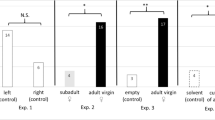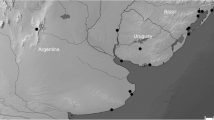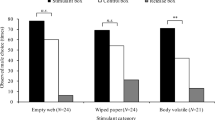Abstract
The use of chemical signals in a sexual context is widespread in the animal kingdom. Most studies in spiders report the use of female pheromones that attract potential sexual partners. Allocosa brasiliensis and Allocosa alticeps are two burrowing wolf spiders that show sex-role reversal. Females locate male burrows and initiate courtship before males perform any detectable visual or vibratory signal. So, females of these species would be detecting chemical or mechanical cues left by males. Our objective was to explore the potential for male pheromones to play a role in mate detection in A. brasiliensis and A. alticeps. We designed two experiments. In Experiment 1, we tested the occurrence of male contact pheromones by evaluating female courtship when exposed to empty burrows constructed by males or females (control). In Experiment 2, we tested the existence of male volatile pheromones by evaluating female behaviour when exposed to artificial burrows connected to tubes containing males, females or empty tubes (control). Our results suggest the occurrence of male volatile pheromones that trigger female courtship in both Allocosa species. The sex-role reversal postulated for these wolf spiders could be driving the consequent reversal in typical pheromone-emitter and detector roles expected for spiders.


Similar content being viewed by others
References
Aisenberg A (2006) Biología reproductiva de las arañas blancas de los médanos (Allocosa spp., Araneae, Lycosidae): aislamiento reproductor entre dos especies simpátridas y sincrónicas, e inversión de roles sexuales. Msc thesis, Universidad de la República, Montevideo, Uruguay
Aisenberg A, Costa FG (2008) Reproductive isolation and sex role reversal in two sympatric sand-dwelling wolf spiders of the genus Allocosa. Can J Zool 86(7):648–658. doi:10.1139/z08-040
Aisenberg A, Viera C, Costa FG (2007) Daring females, devoted males and reversed sexual size dimorphism in the sand-dwelling spider Allocosa brasiliensis (Araneae, Lycosidae). Behav Ecol Sociobiol 62:29–35
Aisenberg A, González M, Laborda A, Postiglioni R, Simó M (2009) Foraging and surface activities of Allocosa alticeps and Allocosa brasiliensis (Lycosidae), two sex-role reversed spiders from coastal sand dunes. J Arachnol 37(2):135–138
Andersson M (1994) Sexual selection. Princeton University Press, Princeton, New Jersey
Ayyagary LR, Tietjen WJ (1987) Preliminary isolation of male inhibitory pheromone of the spider Schizocosa ocreata (Araneae, Lycosidae). J Chem Ecol 13:237–244
Barth FG (2002) A spider's world. Senses and behavior. Springer, Berlin, Heidelberg
Barth FG, Humphrey JAC, Wastl U, Halbriter J, Brittinger W (1995) Dynamics of arthropod filiform hairs, III, flow patterns related to air movement detection in a spider (Cupiennius salei Keys). Phil Transac R Soc London B 347:397–412
Baruffaldi L, Costa FG (2009) Persistence of sexual attraction in female silk threads of a wolf spider. Proceedings of the 46th Annual Meeting of the Animal Behavior Society, Pirenópolis, Brazil, p 43
Becker E, Riechert S, Singer F (2005) Male induction of female quiescence/catalepsis during courtship in the spider, Agelenopsis aperta. Behaviour 142:57–70
Bonduriansky R (2001) The evolution of male mate choice in insects: a synthesis of ideas and evidence. Biol Rev 76:305–339
Candolin U (2003) The use of multiple cues in mate choice. Biol Rev 78:575–595
Christy JH (1995) Mimicry, mate choice and the sensory trap hypothesis. Am Nat 146:171–181
Christy JH, Backwell PRY, Schober U (2003) Interspecific attractiveness of structures built by courting male fiddler crabs: experimental evidence of a sensory trap. Behav Ecol Sociobiol 53:84–91
Costa FG (1995) Ecología y actividad diaria de las arañas de la arena Allocosa spp. (Araneae, Lycosidae) en Marindia, localidad costera del sur del Uruguay. Rev Bras Biol 55(3):457–466
Costa FG, Pérez-Miles F (2002) Reproductive biology of Uruguayan theraphosids (Araneae, Mygalomorphae). J Arachnol 30:571–587
Costa FG, Simó M, Aisenberg A (2006) Composición y ecología de la fauna epígea de Marindia (Canelones, Uruguay) con especial énfasis en las arañas: un estudio de dos años con trampas de intercepción. In: Menafra R, Rodríguez-Gallego L, Scarabino F, Conde D (eds) Bases para la conservación y el manejo de la costa uruguaya. Vida Silvestre Uruguay, Montevideo, pp 427–436
Dondale CD, Hegdekar BM (1973) The contact sex pheromone of Pardosa lapidicina Emerton (Araneida: Lycosidae). Can J Zool 51:400–401
Dor A, Machkour-M’Rabet S, Legal L, Williams T, Hénaut Y (2008) Chemically mediated burrow recognition in the Mexican tarantula Brachypelma vagans female. Naturwissenschaften 95:1189–1193
Eberhard WG, Huber BA, Rodríguez SRL, Briceño RD, Salas I, Rodríguez V (1998) One size fits all? Relationships between the size and degree of variation in genitalia and other body parts in twenty species of insects and spiders. Evolution 52(2):415–431
Eens M, Pinxten R (2000) Sex-role reversal in vertebrates: behavioural and endocrinal accounts. Behav Proc 51:135–147
Elgar MA (1998) Sperm competition and sexual selection in spiders and other arachnids. In: Birkhead TR, Möller AP (eds) Sperm competition and sexual selection. Academic Press, London, pp 307–332
Foelix RF (1996) Biology of spiders. Oxford University Press, New York
Gaskett AC (2007) Spider sex pheromones: emission, reception, structures, and functions. Biol Rev 82:27–48
Gaskett AC, Herberstein ME, Downes BJ, Elgar MA (2004) Changes in male mate choice in a sexually cannibalistic orb-web spider (Araneae: Araneidae). Behaviour 141:1197–1210
Gwynne DT (1991) Sexual competition among females: what causes courtship-role reversal? Trends Ecol Evol 6(4):118–121
Hammer O, Harper DAT, Ryan PD (2003) Past Palaeontological, version 1.18 http://folk.uio.no/ohammer/past
Hegdekar BM, Dondale CD (1969) A contact sex pheromone and some response parameters in lycosid spiders. Can J Zool 47:1–4
Henschel JR (2002) Long-distance wandering and mating by the dancing white lady spider (Leucorchestris arenicola) (Araneae, Sparassidae) across Namib dunes. J Arachnol 30:321–330
Huber B (2005) Sexual selection research on spiders: progress and biases. Biol Rev 80:363–385
Johnstone RA (1995) Multiple displays in animal communication: ‘backup signals’ and ‘multiple messages’. Phil Trans R Soc Lond B 351:329–338
Karlsson B, Leimar O, Wiklund C (1997) Unpredictable environments, nuptial gifts and the evolution of size dimorphism in insects: an experiment. Proc R Soc Lond B Biol Sci 264:475–479
Kasumovic MM, Bruce MJ, Herberstein ME, Andrade MCB (2006) Risky mate search and mate preference in the golden orb-web spider (Nephila plumipes). Behav Ecol 18:189–195
Kronestedt T (1986) A presumptive pheromone-emitting structure in wolf spiders (Araneae:Lycosidae). Psyche 93:127–131
Lorch P (2002) Understanding reversals in the relative strength of sexual selection on males and females: a role for sperm competition? Am Nat 6:645–657
Lubin YD, Henschel JR (1991) Foraging at the thermal limit: burrowing spider (Eresidae) in the Namib desert dunes. Oecologia 84:461–467
Moya-Laraño J, Cabeza M (2003) Bimodality in the body size distribution of Mediterranean tarantula juveniles: Humphreys’ Russian roulette revisited. Rev Ibérica Aracnol 7:211–219
Nieberding CM, de Vos H, Schneider MV, Lassance JM, Estramil N, Andersson J, Bång J, Hedenström E, Löfstedt C, Brakefiled PM (2008) The male sex pheromone of the butterfly Bicyclus anynana: towards an evolutionary analysis. PLOS ONE 3(7):1–12
Olive CW (1982) Sex pheromones in two orb weaving spiders (Araneae, Araneidae), an experimental field study. J Arachnol 19:241–245
Papke MJ, Riechert SE, Schulz S (2001) An airborne female pheromone associated with male attraction and courtship in a desert spider. Anim Behav 61:877–886
Pomiankowski A, Iwasa Y (1993) Evolution of multiple sexual preferences by Fisher's runaway process of sexual selection. Proc R Soc Lond B 253:173–181
Riechert SE, Singer FD (1995) Investigation of potential male mate choice in a monogamous spider. Anim Behav 49:715–723
Roland C (1984) Chemical signals bound to the silk in spider communication (Arachnida, Araneae). J Arachnol 11:309–314
Ross K, Smith RL (1979) Aspects of the courtship behavior of the black widow spider, Latrodectus hesperus (Araneae: Theridiidae), with evidence for the existence of a contact sex pheromone. J Arachnol 7:69–77
Ruther J, Matschke M, Garbe LA, Steiner S (2009) Quantity matters: male sex pheromone signals mate quality in the parasitic wasp Nasonia vitripennis. Proc R Soc B. doi:10.1098/rspb.2009.0738
Rypstra AL, Schlosser AM, Sutton PL, Persons MH (2009) Multimodal signaling: the relative importance of chemical and visual cues from females to the behaviour of male wolf spiders (Lycosidae). Anim Behav 77:937–947
Schulz S (2004) Semiochemistry of spiders. In: Cardé RT, Millar JG (eds) Advances in insect chemical ecology, vol 1. Cambridge University Press, Cambridge, pp 110–150
Schulz S, Toft S (1993) Identification of a sex pheromone from a spider. Science 260:1635–1637
Searcy LE, Rypstra AL, Persons MH (1999) Airborne chemical communication in the wolf spider Pardosa milvina. J Chem Ecol 25:2527–2533
Suter RB, Shane CM, Hirscheimer AJ (1987) Communication by cuticular pheromones in a linyphiid spider. J Arachnol 15:157–162
Thorne F, Neave N, Scholey A, Moss M, Fink B (2002) Effects of putative male pheromones on female ratings of male attractiveness: influence of oral contraceptives and the menstrual cycle. Neuroendoc Lett 23:291–297
Tietjen WJ (1979) Is the sex pheromone of Lycosa rabida (Araneae: Lycosidae) deposited on a substratum? J Arachnol 6:207–212
Tietjen WJ, Rovner J (1982) Chemical communication in lycosids and other spiders. In: Witt PN, Rovner JS (eds) Spider communication. Mechanisms and ecological significance. Princeton University Press, Princeton, New York, pp 249–279
Trivers RL (1972) Parental investment and sexual selection. In: Campbell B (ed) Sexual selection and the descent of man 1871–1971. Aldine, Chicago, pp 136–179
Vollrath F, Parker GA (1992) Sexual dimorphism and distorted sex ratios in spiders. Nature 360:156–159
Wise DH (2006) Cannibalism, food limitation, intraspecific competition, and the regulation of spider copulations. Ann Rev Entomol 51:441–465
Yoshida H, Suzuki Y (1981) Silk as a cue for mate location in the jumping spider Carrhotus xanthogramma (Latreille) (Araneae: Salticidae). Appl Entomol Zool 16:315–317
Acknowledgements
We thank Soledad Ghione, Rodrigo Postiglioni and Carlos A. Toscano-Gadea for their help with field-work. We are grateful to Fernando G. Costa and Andrés González who read critically the first draft of the manuscript. Three anonymous reviewers and the editor Sven Thatje made suggestions that improved the final version of the manuscript. Ted Henderson improved the English. A.A. acknowledges financial support by PDT, Project 15/63, PEDECIBA, Universidad de la República, Uruguay, and Animal Behaviour Society by the Developing Nations Grant awarded to A.A.
Author information
Authors and Affiliations
Corresponding author
Rights and permissions
About this article
Cite this article
Aisenberg, A., Baruffaldi, L. & González, M. Behavioural evidence of male volatile pheromones in the sex-role reversed wolf spiders Allocosa brasiliensis and Allocosa alticeps . Naturwissenschaften 97, 63–70 (2010). https://doi.org/10.1007/s00114-009-0612-z
Received:
Revised:
Accepted:
Published:
Issue Date:
DOI: https://doi.org/10.1007/s00114-009-0612-z




